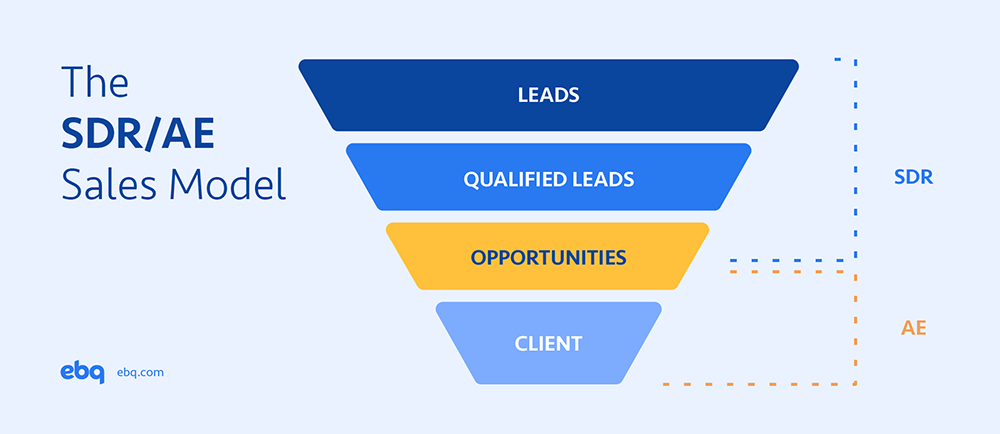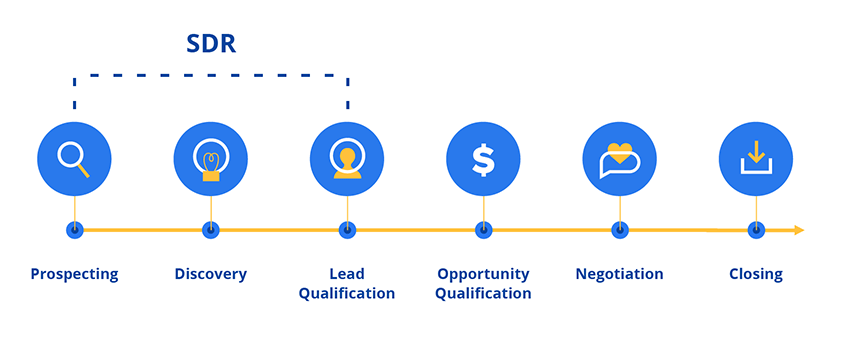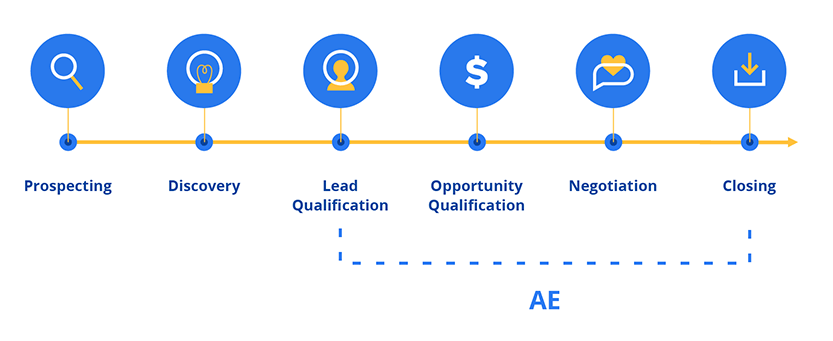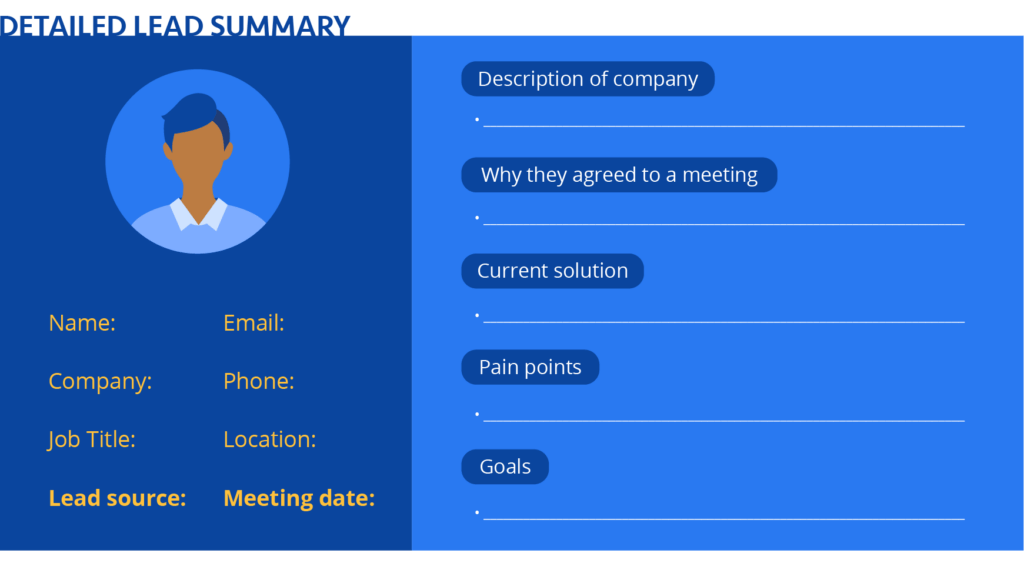In the early 2000s, Salesforce implemented the SDR/AE model for the very first time. 3 years later, they reportedly achieved over $100 million in revenue — inspiring many other organizations to replicate their sales strategy.
Since then, many organizations have adopted this exact model to boost their sales pipeline. However, some sales leaders struggle to make the SDR/AE model work for their business because they find it difficult to keep the sales development reps and account executives aligned.
Our experts will show you how to reduce the friction within your sales team and how to make the SDR/AE model work for your processes.
In this post, we’ll discuss the benefits of the SDR/AE model and 5 ways to fix common challenges of SDR/AE misalignment. We’ll first take a deeper look at what the SDR/AE model looks like.
What is the SDR/AE model?
The concept of the SDR/AE model is to split the sales cycle between 2 distinct specialists to boost productivity. The 2 specialists are the sales development representative (SDR) and the account executive (AE). In theory, investing in an SDR team should increase the pipeline built and the number of deals closed while decreasing the sales cycle length.

What is an SDR in sales?
A sales development representative (SDR) is responsible for the first half of the sales cycle, where they’re in charge of introducing new high-quality leads into the pipeline. They handle all cold calling and prospecting responsibilities so sales reps don’t have to spend as much time finding new leads.

Their primary job functions include:
- Outreach efforts (i.e. phone calls and emails)
- Getting past gatekeepers
- Finding the right decision maker in the organization to sell to
- Qualifying leads
- Scheduling appointments for qualified leads
By having the SDRs focus on getting the right person on the phone, the AEs can focus on converting these leads into actual customers.
What is an AE in sales?
An account executive (AE) is responsible for nurturing qualified leads and closing sales. Unlike the SDRs, the AEs are not expected to prospect. Other names for people in this role include sales representatives, closers, and sales executives.

Their job functions include:
- Identifying the right product/service for the organization
- Negotiating deals and finalizing contract details
- Upselling solutions to existing customers
Below, we’ll outline why the SDR/AE model has the edge in creating more opportunities for your organization.
The benefits of the SDR/AE model
Ultimately, the goal of any sales model is to generate more revenue. However, there are unique advantages to implementing the SDR/AE model:
- Increase in lead conversion rate
- Lower customer acquisition costs
- Increase in productivity
- Increase in specialization
- Lower ramp time for reps
- Cleaner data within your CRM
To see if investing in an SDR team is right for your business model, be sure to check out our post discussing how you can determine if an SDR team is right for you. We even cover some big business goals your SDRs can help you accomplish.
Some may wonder, “well why isn’t the SDR/AE sales model working for my organization?” With that question in mind, let’s dive into some common reasons why your teams are misaligned and how to overcome these challenges.
5 ways to fix SDR/AE misalignment
In spite of the many advantages of the SDR/AE model, some companies report that their sales teams have become misaligned over the years.
Our experts see these 5 common causes of misalignment between these teams:
- SDR to AE ratio imbalance
- Ineffective 1:1 relationships between AEs and SDRs
- Lack of proper note taking in the CRM
- Misalignment over messaging and prospect needs
- SDR commission and quota structure
Below, we’ll outline how to identify and address these challenges to help you create a stronger sales team.
Challenge 1: SDR to AE ratio imbalance
If you have too many SDRs, your AEs will be overworked and let key opportunities slip by. On the other hand, having too many AEs means your AEs will suffer from “empty calendar syndrome.”
To make sure there is a balanced number of SDRs and AEs, many organizations will try to calculate how many SDRs they need per each sales rep. Based on that calculation, they’ll come up with an ideal SDR to AE ratio.
Here are the most common SDR to AE ratios we’ve seen:
1:1 – This is a great starting point that fosters a direct relationship between SDRs and AEs. However, we’ll later dive into why this model is not scalable in the long run.
2:1 – Double the SDRs means getting twice as many leads into an AE’s pipeline. This is great for companies with smaller sales prices, a faster sales cycle, and a large total addressable market.
1:2 – Having twice the number of AEs means your AEs can take their time to follow up on leads. This model is ideal for companies with longer sales cycles and higher-priced solutions.
Keep in mind that more factors go into finding the right SDR to AE ratio for your organization.
Solution: Focus on market need instead of ratio
To make sure your organization has the right balance between SDRs and AEs, we recommend considering the following factors:
- Your industry and target industry
- Your total addressable market
- Your number of MQLs
You’ll find a lot of guides online about calculating the perfect SDR to AE ratio based on your revenue and business goals. However, in our experience, trying to follow a strict golden ratio can actually make it difficult to optimize and scale your process. Considering each organization has its own unique processes, balancing SDRs and AEs has too many factors that can tip the scale.
Instead, look into more effective approaches to optimize this ratio. For example, we recommend assigning SDRs to specific territories — such as by geography, type of account, or alphabetically. This ensures your entire prospect database gets coverage and the model is easier to scale as territories are further expanded or divided.
Challenge 2: Ineffective 1:1 relationships between AEs and SDRs
As mentioned earlier, we found that many organizations rely on a one-to-one relationship between the AEs and SDRs. However, we’ve learned that pairing AEs with SDRs is not the most effective approach in the long run.
First, the AEs simply don’t have time to nurture this partnership. For this one-to-one relationship to work, your AEs and SDRs will need to sit down regularly to discuss everything from strategy to messaging alignment. While the AE and SDR teams should regularly discuss strategy, relying on a one-to-one relationship means your AEs won’t have the time to do what they’re asked to do: close deals.
Pairing the SDRs and AEs together also means that you’ll lose process standardization. You’ll soon find that you’ll have 7 playbooks for 1 play because different AEs have different methodologies to achieve the same goal. This makes it difficult to optimize your sales process in the future, which will impact your business’ scalability.
Without standardization, it’s near impossible to evaluate SDR performance objectively. Since they’d all be following different processes, you won’t be able to find a common denominator to judge their successes on. This means that it’ll be difficult for your SDRs to collectively find room for improvement in your sales process.
To make sure you’re objectively evaluating your SDR team’s performance, make sure you review our SDR metrics to make your team successful. We even touch on our own unique lead qualification scoring system that helps us accurately visualize how prospects progress through the pipeline.
Finally, pairing the SDRs and the AEs together will inhibit the SDRs from learning from other AEs. The best thing about sales is that there’s no singular right way to sell a solution to a prospective customer, so let your SDRs and AEs learn new techniques from each other! That way, they’ll understand how to connect with different prospects through different perspectives.
So if relying on a 1:1 relationship won’t work, then what will?
Solution: Create a management layer to drive the day-to-day strategy
With a strong SDR management layer, the SDRs can report to 1 sole manager rather than relying on the AEs’ individual ability to mentor their respective SDRs.
The management layer is responsible for the sales development team’s overall performance; they’re motivated to optimize the process to increase the number of leads qualified. This allows your team to standardize their process, as everyone’s graded on the same scale.
We’ve found that having a management layer also promotes cross-team collaboration, as the SDRs can learn from a wide range of AEs on different sales techniques to connect with prospects. This also prevents your SDRs from feeling siloed and gives them more visibility into the full sales process.
If you’re looking to outsource your SDR team with a built-in management layer, EBQ offers an entire appointment setting team at a fraction of the cost. Not only are we well-versed in a wide range of industries, but we also offer both a project manager and a success manager to drive your strategy. Whether you’re a startup looking to get your foot in the door or an enterprise looking to expand your pipeline, our SDRs are just a call away.
Challenge 3: Lack of proper note taking in the CRM
Another challenge we’ve seen organizations struggle with is SDRs and AEs not effectively utilizing the prospect database in their CRM. This results in sales reps not having the information they need to nurture opportunities and even impacts your ability to report on overall sales success.
SDRs need to be on the same page as the AEs about where to record prospect information and past call notes. Your SDRs may not know what info they need to include or fields to fill out for each prospect — making it difficult for your AEs to access what they need to know for a successful sales call.
Many organizations also struggle with getting everyone to care about their CRM data, so your very first step is finding a creative way to get everyone onboard, such as relating CRM tasks to business outcomes and performance metrics.
If you haven’t already invested in a single source of truth, we’ve discussed the various benefits of investing in a CRM across different departments in another post: How Different Teams Use a CRM. You’ll soon find that using a singular CRM across the company will help improve your relationships with prospects and customers.
Solution: Establish a standardized sales process using a playbook
Now that you know how to get your sales team to care about your data, let’s talk about how to make sure the information collected is sufficient and standardized.
We first recommend you standardize the way your SDRs are recording their call notes within your CRM. Outline this standardized process in a playbook for your teams. You can also create required fields in your CRM for SDRs to fill out before the prospect is qualified for the next sales stage.
These notes should be shared readily with your AEs, and it’s standard practice to also directly send AEs a lead summary ahead of the call.

A lead summary is a digital card with key details about a prospect, such as:
- Basic information about the contact and company (e.g. name, location, industry, size, revenue, etc.)
- When the sales meeting is scheduled
- How they found out about your product or services
- High-level description of what the company does
- Current solution or alternatives they’re looking into
- Why they agreed to the meeting
- Their decision drivers and pain points
- Their goals and what success looks like to them
- Any other relevant information your AEs need to know
We can’t stress enough the importance of these call notes. Your call notes need to outline what happened in that conversation, and more importantly, why the prospect agreed to meet with your sales representatives in the first place. Although this shouldn’t be an explicit question, our experts suggest developing a call script that helps your sales team identify your prospects’ decision drivers.
From there, the AEs need to be held accountable for recording the status of their projects consistently. That way, your SDR team can review the progress and tweak their process to go after high-quality prospects based on data.
A key benefit of keeping your CRM updated and your data clean is that it’ll protect your organization from turnover effects. If a salesperson decides to leave your organization someday, you won’t have to worry about them taking their expertise and individual notes on your customers with them. With all of these call notes stored in a cloud, the next salesperson can quickly pick up where the last salesperson left off.
Challenge 4: Misalignment over messaging and prospect needs
A common issue for SDR and AE teams is using consistent messaging when targeting specific prospects. Your SDRs are responsible for listening to decision makers and determining their biggest decision drivers. From there, sales needs to communicate with the right messaging to transform these opportunities into sales.
For example, your SDRs and AEs need to agree on the following factors when choosing which sales messaging to use:
- Which benefits are you going to highlight when selling your solution?
- What buyer persona do they fit into (e.g. their job titles, industries, etc.)?
- What motivates your prospect into committing to your solution?
- What obstacles do they face to stop them from converting?
This means that it’s important for everyone to understand not only who to pitch specific solutions to, but also how you approach these prospects.
If your SDRs or AEs pitch your prospects with the wrong strategy, you may appear unprofessional. Without a way to make sure everyone is on the same page, you’ll find that your sales team will be missing out on huge opportunities.
Solution: Define qualification standards using an internal playbook
By explicitly defining what makes a prospect great in your book, your SDRs will understand what they should be looking for when qualifying leads. If you haven’t already, take the time to record these expectations in your internal playbook.
Here are a few examples of criteria to include:
- What job titles should your SDRs focus on?
- What industry are these organizations a part of?
- What’s their company size?
- What’s their annual revenue?
You can take the time now to properly align your sales messaging and make sure you’re properly communicating your unique selling proposition to prospects that meet these criteria. This is also a great way to make sure your AEs and your SDRs are on the same page as to when and how the handoff should happen.
If you’re looking for additional inspiration for developing your lead qualification system, be sure to read our post about the lead qualification process. This article outlines how our SDRs qualify each prospect using our very own lead qualification scoring system: the EBRating.
Solution: Perfect your SDR to AE handoff
Up until an appointment is set, your SDRs have been the liaison between your organization and your prospect. They’re the ones on every call thus far, so it’d make sense to assume that the SDRs know your leads the most.
That’s why we highly recommend having the SDRs join at least 1 meeting between the AE and the prospect. During our calls with clients’ leads, our SDR introduces the AE to the prospect and gives a quick rundown of what the prospect can expect. This process is called a warm handoff, and it’s an easy way to create a better customer experience for your prospects.
By perfecting the SDR to AE handoff, you’ll see a better team alignment between your SDRs and your AEs. That’s because a clear expectation has been set and everyone is on the same page as to how they should approach these prospects.
Challenge 5: SDR commission and quota structure
How do you motivate your SDRs to find high-quality leads? For many organizations, it’s standard practice to base your SDRs’ pay on if their lead turns into an opportunity. However, we’ve found that basing your SDR pay on your AE’s ability to close deals will negatively impact team morale.
You’ll find that sales reps don’t always remember to keep their opportunity statuses up-to-date in the CRM. This causes friction between your SDRs and AEs, as your SDRs would be waiting for your AEs to eventually update opportunities that have since moved onto the next stage.
Not every AE knows how to close each deal effectively — even if the SDRs think that there’s a high chance of the prospect closing. Tying SDR pay to an AE’s ability to close deals inevitably leads to frustration from the SDR team.
To minimize this frustration, we recommend hiring experienced salespeople who can maximize the number of deals won. If you’re looking for experienced account executives, our outsourced sales team can help capture more opportunities. Visit our outsourced sales services page to learn more.
Solution: Foster a company culture that promotes team cooperation
Just because you’re not tying your SDRs’ pay to the final outcome of your leads doesn’t mean you can’t appreciate their hard work. There are other ways to keep your SDRs invested in finding great leads for your AEs.
For starters, our experts recommend creating a bonus structure for outperforming SDRs. That way, your SDRs are still taken care of during slower seasons, but they’re still motivated to outdo themselves month after month.
You should also give your SDRs the opportunity to sit in on the AEs’ time with the prospect. If your AEs are lucky enough to enjoy a lunch with a prospect, we recommend opening that invitation to your SDR as a way to show gratitude.
For bigger deals, you can think about sending over gift baskets to the SDR responsible for introducing the lead into the pipeline in the first place. This can be a physical representation of how much you appreciate your SDRs’ hard work.
By fostering a culture that promotes team cooperation, you decrease the chances of creating a toxic environment that’s filled with resentment. Instead, you reward your top-performing SDRs for doing great work.
Making the SDR/AE model work for you.
The SDR/AE model is still a great way to increase the number of deals won and decrease the sales cycle length. However, it only works if you implement the sales model strategically.
After reading this post, you should know:
- The advantages of using the SDR/AE model
- Why your SDRs and AEs may be misaligned
- How to overcome these challenges
We understand that building both an AE team and an SDR team can be challenging and costly. That’s why we’ve seen many organizations turn to outsourcing to keep overhead costs low and protect themselves from turnover.
To achieve their goals, many organizations turn to us to outsource their sales representatives. We can quickly adapt to your unique processes and fill in the gaps within your sales team.
If you’re looking to outsource your sales development team, our SDRs have the skills and experience necessary to expand your pipeline and help you scale. Visit our sales development page to learn more.


